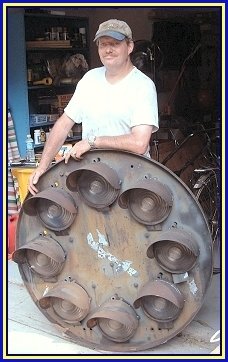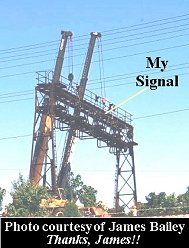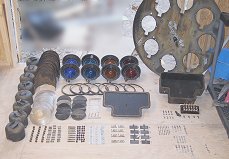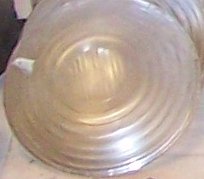 |
|
wrestle two signals - one for him and one for myself - from the fallen bridge at Halethorpe on August 3, 2007. |

 |
|
wrestle two signals - one for him and one for myself - from the fallen bridge at Halethorpe on August 3, 2007. |

This is one of eight CPLS which guarded the interlocking at "HX" Tower. The whitish substance near the center of the target and below the rightmost lamp is residue from duct tape used to seal black plastic bags around the signals when they were taken out of service but while the signal bridge remained standing.
 The estimate on when this signal was put into operation is around 1951; to me that's ideal,
because it means that this signal saw the transition from steam to diesel, the demise of
passenger railroading by private railroad companies, the merger of the Chesapeake and Ohio, the
Western Maryland and the Baltimore and Ohio into the Chessie System and then into CSX, and it
saw the end of an era when it itself was replaced in July of 2007 with what look like
traffic signals..
Oh, how I wish this signal could talk!
Well, the first thing I had to do was build a shed in which I could work on my signal. :My wife
made it clear that I was NOT going to refurbish the signal in the basement - which was fine with me; it
gave me an excuse to build a nice new 12' x 16' barn-shaped shed in the backyard. Now that it's
mid-October and the shed is finished to the point that we've moved all of the stuff from the garage to
the shed, I figured it was time to start refurbishing my beloved CPL.
The estimate on when this signal was put into operation is around 1951; to me that's ideal,
because it means that this signal saw the transition from steam to diesel, the demise of
passenger railroading by private railroad companies, the merger of the Chesapeake and Ohio, the
Western Maryland and the Baltimore and Ohio into the Chessie System and then into CSX, and it
saw the end of an era when it itself was replaced in July of 2007 with what look like
traffic signals..
Oh, how I wish this signal could talk!
Well, the first thing I had to do was build a shed in which I could work on my signal. :My wife
made it clear that I was NOT going to refurbish the signal in the basement - which was fine with me; it
gave me an excuse to build a nice new 12' x 16' barn-shaped shed in the backyard. Now that it's
mid-October and the shed is finished to the point that we've moved all of the stuff from the garage to
the shed, I figured it was time to start refurbishing my beloved CPL.
 ALL the pieces of the signal (and this is WITHOUT the junction board disassembled!) |
 |
 Next I removed the little metal pieces that protect the wires as they pass from the junction box into the
individual lamp units, then I removed the individual lamp units themselves. The lamp units are held onto the
target by large brass nuts; there are also compression springs on each of three rods which protrude through
the signal head; these springs and the compression placed on them by the brass nuts on the face of the signal
allow each lamp unit to be aimed.
After all the lamp units were removed I removed the junction box from the rear of
the signal head. A cast iron behemoth itself, the junction box weighs in at 33 pounds WITHOUT its cover;
the cover is another 12 pounds, and the bare target weighs 64 pounds.
A CPL signal comprises literally hundreds of pieces; as shown in the picture to the left there are 73 pieces to each lamp unit. I suppose my signal has a few more pieces since it
has all four possible indications, whereas many CPL units have three or fewer indications.
Next was cleaning of the inner lenses. Six of the eight lenses - red, amber and green - are glass;
the remaining two lenses - blue for "lunar white" - are Lexan. I replaced the plastic lunar lenses with glass
lenses and I replaced the eight outer lenses with new Lexan lenses.
The replacement lenses were obtained from
Next I removed the little metal pieces that protect the wires as they pass from the junction box into the
individual lamp units, then I removed the individual lamp units themselves. The lamp units are held onto the
target by large brass nuts; there are also compression springs on each of three rods which protrude through
the signal head; these springs and the compression placed on them by the brass nuts on the face of the signal
allow each lamp unit to be aimed.
After all the lamp units were removed I removed the junction box from the rear of
the signal head. A cast iron behemoth itself, the junction box weighs in at 33 pounds WITHOUT its cover;
the cover is another 12 pounds, and the bare target weighs 64 pounds.
A CPL signal comprises literally hundreds of pieces; as shown in the picture to the left there are 73 pieces to each lamp unit. I suppose my signal has a few more pieces since it
has all four possible indications, whereas many CPL units have three or fewer indications.
Next was cleaning of the inner lenses. Six of the eight lenses - red, amber and green - are glass;
the remaining two lenses - blue for "lunar white" - are Lexan. I replaced the plastic lunar lenses with glass
lenses and I replaced the eight outer lenses with new Lexan lenses.
The replacement lenses were obtained from
 Continued...
Continued...
 Back to Mike's Railroad Page
Back to Mike's Railroad Page
